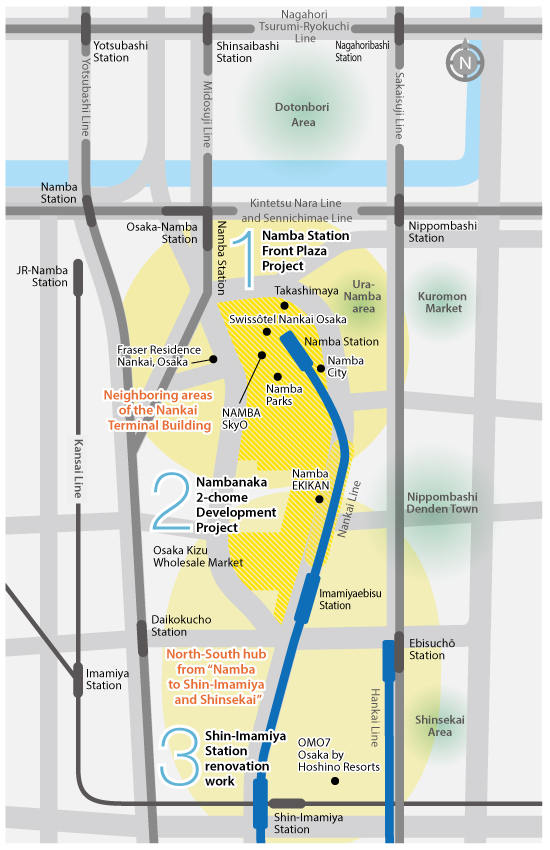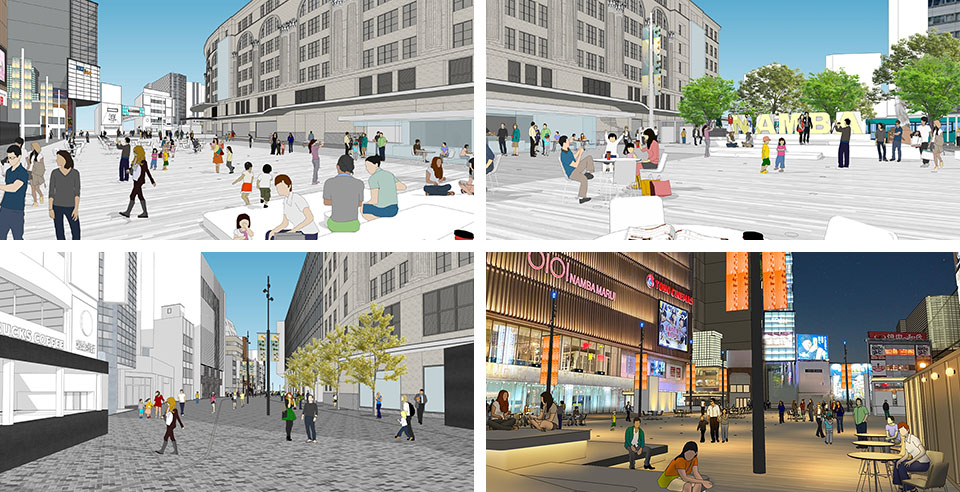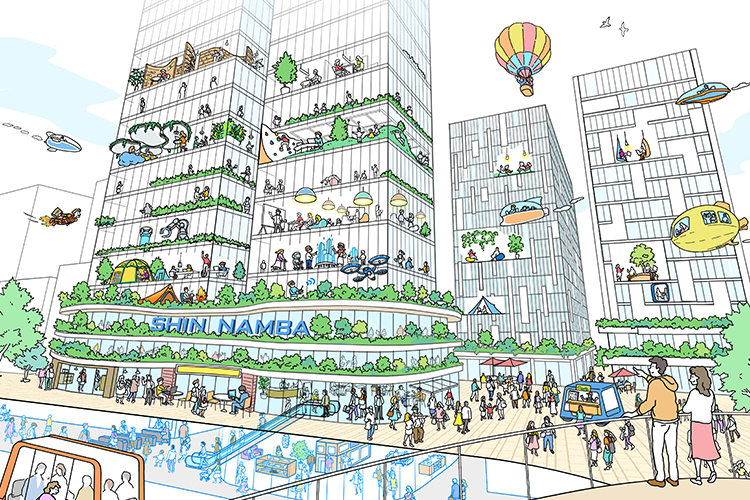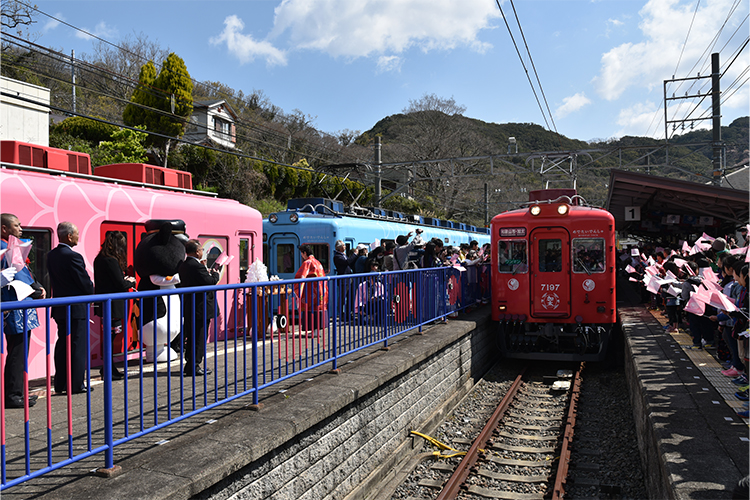Thriving and friendly community development
(Initiatives Example)
Initiative guidelines
We will develop areas that maximize Namba’s potential and build a foundation to bring back the population that has become concentrated in cities to the areas along our railway lines by capitalizing on local resources such as the nature and the countless tourism resources and historical assets in each area, and communicating with diverse stakeholders.
Revitalizing the Namba area
Creating Greater Namba with two supporting pillars: developing the zone adjacent to Nankai Terminal Building and developing a north-south route between Namba and Shin-Imamiya and Shinsekai

In 2018, we devised a Greater Namba concept to create a lively location for people to shop around in, by developing the north-south route between Namba Terminal and Shin-Imamiya/Shinsekai. With tourists coming back to Japan, the Expo scheduled for 2025, the integrated resort (IR) set to open in 2029, and the Naniwasuji Line opening in 2031, we are trying to build a place in Namba and Shin-Imamiya for people to visit, stay, and live in, where they can have new encounters and interactions.
Namba Station Front Plaza scheduled to complete in 2023
Together with the “Community Development Council for Safe, Secure and Lively Namba,” which many shopping streets and corporations have joined as members, we have evaluated the idea of redeveloping the area in front of Nankai Namba Station as a pleasant human-centric space.
In August 2020, it was decided that we would design and construct the space as a part of the Namba Station Area Redevelopment Project, a joint Public Private Partnership project with Osaka-shi.
We will create a new space that will be a new symbol for the lively global downtown of Osaka's Minami area.

Taking part in the Nambanaka 2-chome Development Project, to be completed in 2023
In plot A (approximately 4,404 square meters), we are engaged in the sub-leasing of the land that we have rented. A high-end hotel by Centara Hotels & Resorts is scheduled to open as the first of its kind in Japan.
In plot B (approximately 2,505 square meters), three companies, including us, have established a special-purpose company to develop office buildings.
In plot C (approximately 2,004 square meters), three companies, including us, have started developing a hotel as a joint venture. Hotel Keihan Namba Grande (tentative name) is scheduled to open. To ensure seamless connection with Namba Parks, the hotel is designed to make guests feel at home despite being in the city center, with the exterior design concept being “green hill strata.”
Updating Shin-Imamiya Station and the surrounding community
The renewal construction for Shin-Imamiya Station that was started on October 19, 2020 (Mon) was completed on March 26, 2022 (Sat). OMO7 Osaka by Hoshino Resorts was opened on April 22, 2022 (Fri) on the east side of Shin-Imamiya Station, which has the second highest number of passengers after Namba Station, greatly changing its surroundings. The area has been redeveloped with the understanding that the station plays a significant role as part of the community building for the Shin-Imamiya and Shinsekai area.
Key measures included moving the ticket gate that had been on the second floor to the first floor, building larger elevators, making the south-to-north alley more appealing, and improving the station concourses to improve customer convenience and satisfaction.
For the Shin-Imamiya area, to attract people of different nationalities and generations, we did the Ebisu-cho Land Development Project, which includes shared corporate dormitories, and opened YOLO BASE, a space to connect Japanese and non-Japanese people; Nanigotoya, a place where art and music come together; and Sankakuchi, a hub to create a welcoming and thriving atmosphere for the area.
Going forward, we will continue to create a lively location for people to shop around in along the north-south route between Namba and Shin-Imamiya/Shinsekai.




Revitalizing local communities with railway stations as hubs
We have been promoting community development and the revitalization in the areas along our railway lines through commercial buildings, office buildings, residential development, running leisure facilities, and other activities focused around the major stations on our railway lines. “Ki:no Wakayama,” a complex facility directly connected to the Wakayamashi Station, which is the southernmost terminal of the Nankai Line, celebrated its grand opening in June 2020. The complex includes an office zone, commercial zone, a hotel, and the Wakayama Civic Library, and uses an abundance of Kishu timber for the structure, with the aim of letting customers enjoy high-quality items that are “unique to Wakayama.” The commercial zone saw approximately 2.1 million customers in its second year.
Additionally, we are aiming to create a thriving atmosphere with more tourists at Wakayamashi Station and its vicinity, with the sightseeing train “Medetai Train” running between Wakayamashi Station and Kada Station. Furthermore, a “HYDE Southern” wrapped train is running between Namba Station and Wakayamashi Station (and Wakayamako Station) from December 2019 to May 2022, as a collaboration with HYDE, an artist who is also the tourism ambassador of his hometown Wakayama City.


Preserving and utilizing tourism resources
Koya-san Sightseeing Enhancement Project
Based on our belief that the understanding and cooperation of the local region is essential for “promoting tourism,” we are working together with municipalities, tourism-related organizations, and other businesses in areas along our railway lines to attract customers to tourist sites, such as Koyasan, which is a World Heritage Site and one of the most sacred areas for Buddhism in Japan.
For instance, there is a growing demand for a new type of travel called “micro-tourism,” in which people go sightseeing in regions near them, so we held a “food experience tour in collaboration with local tourism businesses, etc.,” in the Izumisano area, along with “special guided shrine tours by priests” at the Sumijyoshi Taisha Shrine. For overseas visitors, we have been sharing information in a timely manner using the Internet and social media, even during the period of time when there were travel restrictions, to spread information on areas along our railway lines and attract visitors in anticipation of the end of the COVID-19 pandemic.
The Medium-term Management Plan “Kyoso 140 Plan” includes tourism-related businesses and is likely to become a pillar in our new management. We will continue to preserve and utilize tourism assets in the areas along our railway lines for “new value creation and to boost the number of people interacting through the promotion of tourism,” along with the “development of sustainable business models related to tourism.”


Collaborating with stakeholders to enhance the value of areas along our railway lines
Promoting the appeal of the Kada Sakana Line
The route connecting Kinokawa Station to Kada Station has been given the nickname “Kada Sakana Line.” Together with organizations such as local tourist associations, we have been conducting activities for the “Kada Sakana Line Project” to promote the attraction of these areas along our railway lines. As part of this initiative, we have been operating the sightseeing train “Medetai Train.” Since starting the operation of the “Medetai Train,” we have been seeing definite results in the project. A busy year may see an increase of approximately 35,000 more non-commuter passengers at Kada Station, which had been on a declining trend.

Supporting innovation and revitalization at businesses along our railway lines
We have been proceeding with #BIZ TAG NANKAI, a collaborative creation project to build the appeal of businesses along our railway lines, aiming to increase the number of attractive workplaces and the number of people who work in areas along our railway lines.
In FY2021, the “Kotatsu Job Hunting Expo” and the “Mystery Industry Research EXPO” were held. These are exchange-type joint information meetings targeting businesses along the railway lines and job-hunting individuals. Additionally, we held the “Assist innovation by companies along our railway lines” workshop for young successors of businesses along the railway lines, helping them to create ideas for new businesses. These initiatives are conducted with the cooperation of various governments, municipalities, chamber of commerce and industry, financial institutions, universities, and other organizations in areas along our railway lines.


Developing communities to support enjoyable child-raising
We launched the “Smiles for Families +1 Project” in FY2021, to promote the enjoyment and feelings of attachment in child-rearing families toward living in areas along our railway lines, and to have those areas be recognized as attractive areas to live in. With the aim of “providing a wide range of opportunities to nurture ‘budding curiosity’ within children in areas along our railway lines, and co-creating communities in which child-rearing is enjoyable,” we cooperated with municipalities and companies along the Nankai lines in FY2022 and held a total of 29 hands-on events in the summer, called “‘Exciting Experiences for Parents and Children! Along the Nankai Line’ Let’s Nurture Children’s Curiosity .

Sustainability Site Map
(materiality)
- Major sustainability themes (materiality)
- Identification processes
- Further seek safety, security, and satisfaction
- Thriving and friendly community development
- Create a future full of dreams
- Achieve an enriched life
- Develop a workplace and staff in a way that enables each person to put their abilities to use
-
Contribute to preserving the global environment
- Environmental philosophy
- Reducing CO2 emissions in response to climate change, promoting the use of renewable energy, and so forth
- Bringing about a circular society
- Preserving biodiversity
- Deepening our environmental management
- Expanding environmental buildings (green buildings)
- Responses to TCFD Recommendations
- Bolster a corporate foundation that is sincere and fair
